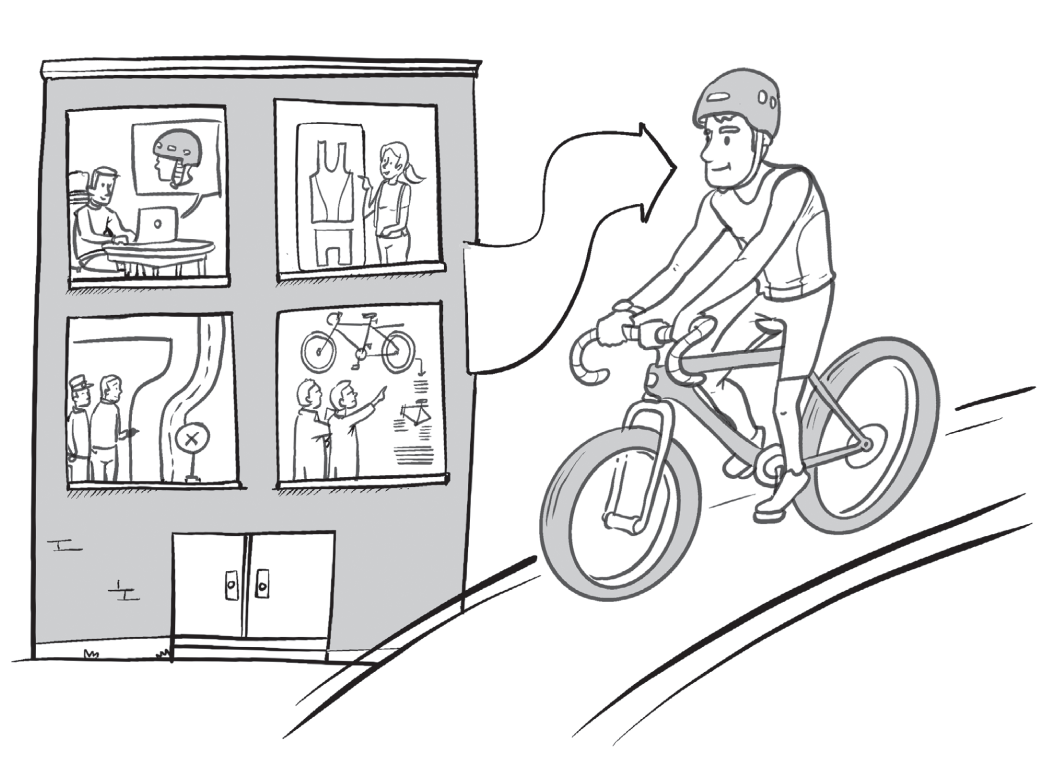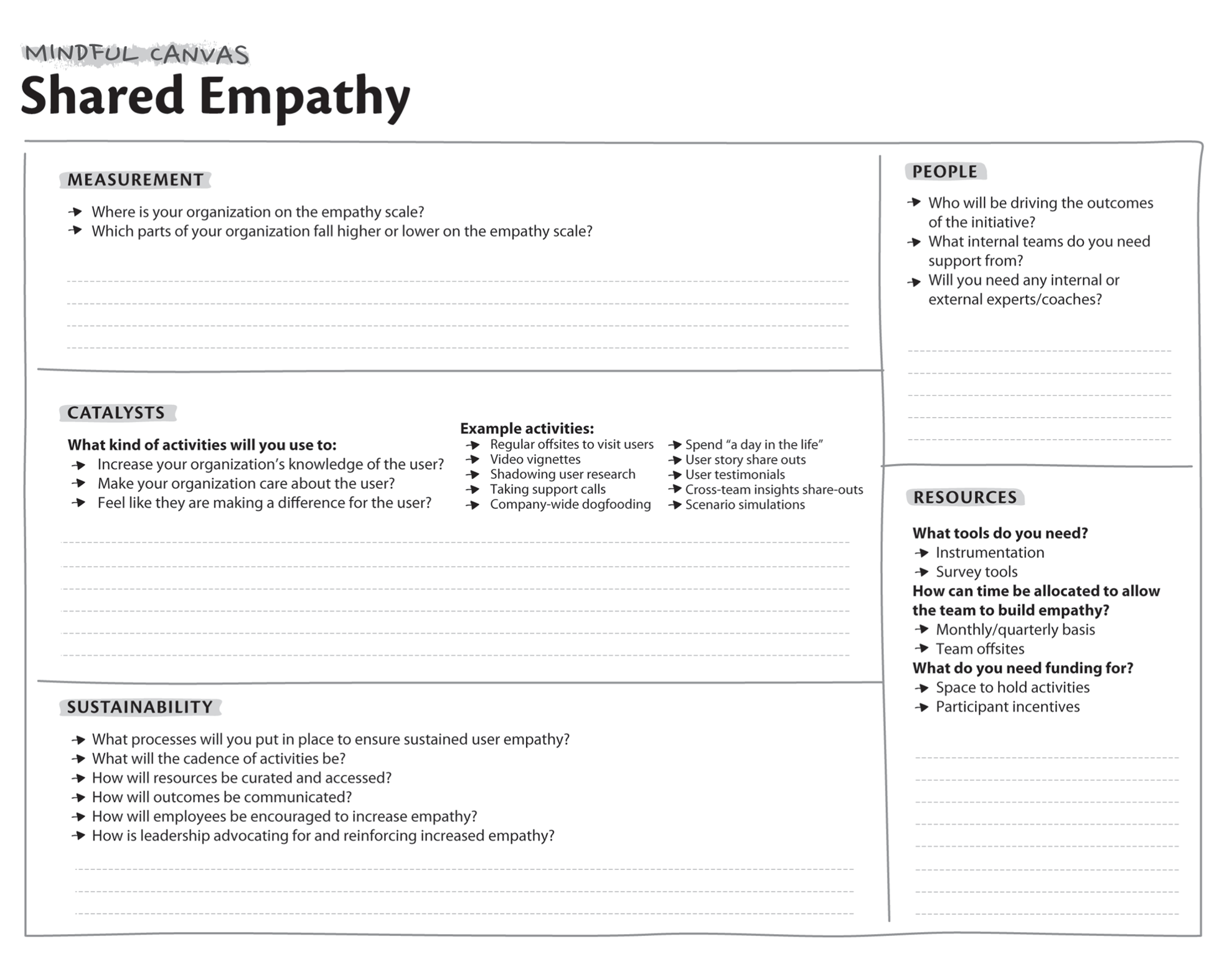CHAPTER 17
SHARED EMPATHY PLAY: How do I grow the collective user empathy of my organization?
User empathy is an organization‐wide responsibility. The best user‐centered innovation happens when every individual within an organization—across all departments, from the junior hires to the most senior staff—rallies around a common purpose and desire to make an impact for their users. UXReactor’s “Shared Empathy” play allows you to measure, increase, and sustain your organization’s place on the empathy scale, increasing user satisfaction while decreasing internal product churn.

who are the key players in the shared empathy play?
| ROLE | WHO’S INVOLVED | RESPONSIBILITIES |
|---|---|---|
 DRIVER | Experience strategist |
|
 CONTRIBUTOR | Experience design practitioners, cross‐functional teams |
|

THE HOW
To run an effective shared empathy play, you need to be mindful of:
1. MEASURING Empathy
The empathy scale measures the degree to which your team is able to understand and relate to your users. It shows where empathy is strong or weak in your organization and informs your rollout strategy for the shared empathy play.
This assessment should be distributed to a representative sample in your organization, spanning all levels and positions. The final score will show you:
- The breadth of empathy across your organization: How many teams have empathy for your users;
- The depth of empathy in your organization: How strongly your organization empathizes with your users;
- The level of intent of your organization: How strongly your teams and employees believe in your organization’s purpose to solve problems for your users.
Based on the resulting scores, your organization will fall into one of the following five levels of empathy maturity:
- Level 1:Task‐Driven—Most members in non‐sales or support roles of your organization have never interacted with a user. They perform tasks as they are assigned. Users are seldom or never brought into the innovation process, and teams experience significant churn. User insights and product decisions come from one or two groups in the organization.
- Level 2:SME‐Driven—A select few members of your organization understand your users and act as the subject‐matter experts (SMEs) for the rest of the organization. The majority of the organization who are not in sales or support roles have never interacted with a user; they learn about users through these SMEs. User insights and product decisions come from a few groups in the organization.
- Level 3:Functionality‐Driven—As an organization, there is sufficient understanding of what users do day‐to‐day, and products and services are produced to meet these known needs. Users are brought into the innovation process to validate decisions. Innovation happens from a feature and functionality perspective, allowing users to do the jobs they need to perform. Along with sales and support, the product and UX teams interact with users to gather insights and help make product decisions.
- Level 4:Value‐Driven—The organization supports a regular cadence of research to identify opportunities for innovation. There is an understanding of the users in the context of the wider systems, and innovation is done collaboratively to drive value for the user through better and more efficient technologies. Users are brought in at multiple points of the innovation process, and many groups within the organization interact with users.
- Level 5:Purpose‐Driven—The user is front and center at all times. There is high compassion for the user across the whole organization; everyone is driven by the desire to solve problems and make a meaningful impact for them. Innovation is an organization‐wide collaborative effort. Users are brought in not just for research but to interact and share their experiences with everyone in the organization.
Track your organization’s score over time and re‐assess on an ongoing basis. This will become one of the organizational KPIs you track when measuring experience impact. (Chapter 28: “Experience Metrics Play”)
2. The Right CATALYSTS for Increasing Empathy
Institutionalize activities that will increase your organization’s empathy for your users. These activities should:
- Increase your organization’s knowledge of its users;
- Make your organization care about its users;
- Feel like they are making a difference for its users.
These activities should be present at multiple touchpoints within your organization. Increasing empathy is an ongoing process, so all employees in your organization, regardless of position, should take part in these activities on an ongoing basis.
Here are some empathy‐increasing activities you can try with your organization:
- Regular offsites to visit users;
- Library of video vignettes of users;
- Shadowing user research;
- Taking support calls;
- Company‐wide dogfooding;
- Spend “a day in the life”;
- User story share outs;
- User testimonials;
- Cross‐team insights share outs;
- Scenario simulations.
3. The SUSTAINABILITY of Your Empathy
Instilling empathy is not a set‐it‐and‐forget‐it endeavor; it is an ongoing effort. To ensure sustained and growing user empathy in your organization, institute processes around:
- The cadence of your activities;
- Keeping teams and individuals accountable for taking part in the activities;
- Curating and sharing resources (Chapter 29: “Insights Curation Play”);
- Communicating outcomes;
- Constant advocacy and example setting by leadership.
In many organizations, even if multiple groups are conducting research, the findings often stay in silos. An effectively run shared empathy play coordinates multiple activities at once, but just as importantly, it also puts systems in place to ensure collaboration and conversation are happening.
4. The PEOPLE to Nurture Empathy
Facilitating shared empathy in your organization will require collaboration between many teams and a primary driver to take ownership of the final outcomes. To be successful in this role, the driver will need a strong understanding of the importance of empathy, how to establish measures of success, and how to orchestrate cross‐functional efforts. Typically this should be led by the CXO or another designated driver for an organization.
5. The RESOURCES to Support the Initiative
Dedicate resources to this initiative to enable its launch and continued success. Based on the activities and processes you put into place, assess your need for:
- Tooling, such as instrumentation and survey tools;
- Time allocation for all team members to take part in the activities;
- Funding for a space to hold the activities, participant incentives, ongoing maintenance, R&D, and more.
IN ORDER TO MAXIMIZE THE VALUE OF THIS PLAY
- Lead by example: This play and its activities must apply equally to everyone in the organization, regardless of each individual’s position. Those in leadership positions should encourage participation by first setting the example of making user empathy a priority.
- Communicate impact often: Instill a sense of purpose by communicating the impact your organization’s work is having on the users as often as you can.
- Proactively prevent silos: Even in user‐first organizations, silos happen. When learnings and insights are not cross‐shared, different groups of the organization begin to think of users through their own particular lenses. This is not conducive to a collaborative innovation process.
 RELATED PLAYS
RELATED PLAYS
- Chapter 14: “User Empathy Play”
- Chapter 28: “Experience Metrics Play”
- Chapter 29: “Insights Curation Play”
